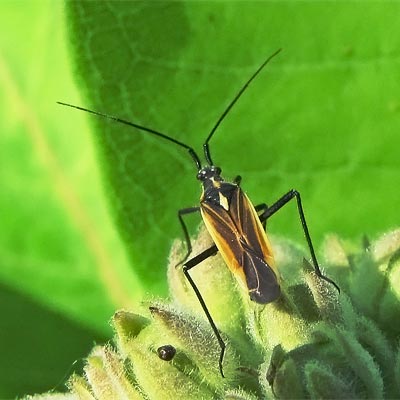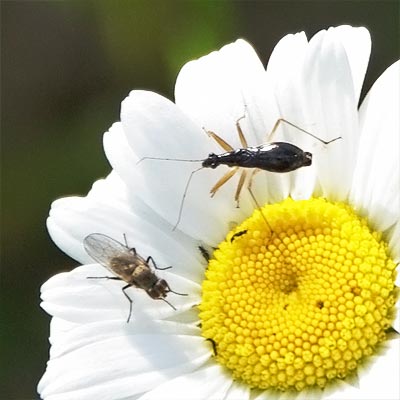Salutations, BugFans,
When the BugLady goes on-line to research a BOTW, she is always interested in the ratios of the various hits—photos to informational articles to research to species lists to exterminators. There were an amazing number of pictures posted of this small, soft-bodied, pretty, but definitely not “sexy” bug (oops—lost the IT censors again).
Meadow Plant Bug
The Meadow Plant Bug (Leptopterna dolabrata) is a member of the plant bug family Miridae. Almost anyplace in the world where plants will grow, Mirids will, too. According to the BugLady’s sources, Leptopterna means slender heel and dolobrata means mattock-shaped (not sad bratwurst). The BugLady thinks it all may refer to the long, slim shape of the Meadow Plant Bug (MPB). The MPB is an originally-Eurasian insect (there are web articles about it in a variety of languages and alphabets) that now lives in a band across the central and northern U.S. and southern Canada. Despite–or maybe because of–the fact that it is an alien and a pest, there are some very cool things about the MPB.
As its name suggests, the MPB hangs out in meadows and other grassy places, especially grasslands not used for grazing. Remember, the grass family includes domesticated grain crops, too, and there the MPB’s diet gets it in trouble. It eats plant juices found in the grain’s seed, puncturing a seed from above with its piercing mouthparts. This feeding can shrivel the seeds and cause a condition called “white-ears”—sterile seed heads. Although some studies show that they resort to cultivated grasses only after the native grasses dry up, MPBs are not popular with grain farmers or with people who grow grass for seed. They have a fondness for Kentucky bluegrass—itself an alien species. MPBs prefer grasses that are high in nitrogen; they feed more avidly on low-nitrogen plants, and they will move to more nutritious plants. MPBs exude a sticky saliva as they feed, and according to one source, the residue of this saliva can break down wheat’s gluten midway through the bread-making process, turning a yeast dough into a runny mess.
Besides dinging the top end of a grass plant, the MPB can also damage the lower end. Ms. MPB has cutting teeth on her ovipositor (egg depositor) with which she makes a hole for her eggs near the base of the grass stems, below the mowing/grazing line. This can injure the stems. When grasses are too tough for her, she leaves her eggs on the outside of the stem.
MPBs overwinter in the egg stage. As temperatures decline, so does the development of the MBP embryo within the egg. Because MPBs practice incomplete metamorphosis, their young (called nymphs) hatch out in spring looking like their elders, except for wings and reproductive organs. These they grow during five successive molts.
OK, fasten your seatbelts. MPBs exhibit wing polymorphism; males are macropterous and females are brachypterous (except when they’re not—read on). Let’s, as they say, “unpack” that sentence. Poly-morphism means many forms. Pterous comes from the Greek pteron, or wing. Macro-pterous males are large/long-winged; brachy-pterous females are short/partly-winged.
Scientists have discovered that short-winged females produce more eggs than their long-winged sisters (one study said 60 or 70 vs 2), and that these brachypterous gals are more common in the northern parts of their range. Makes sense to produce more offspring in harsher conditions. Scientists are able to manipulate the bugs’ winged-ness by crowding them. When nymphs, especially older nymphs, are concentrated, more macropterous females developed (makes sense—the wings develop as the nymph matures, and crowding reduces food supplies).
The guess is that this is a dispersal dimorphism (two-forms). The clever long-winged females disperse before they are gravid (full of eggs) because even though they sport long wings, they are twice as heavy once they are egg-laden. One source differentiated between the bugs’ trivial flights (short, everyday movements) and true flights (dispersal flights or movements outside their normal habitat). The BugLady is dismayed to discover that most of her flights are trivial.
Next time the BugLady meets a MPB, she plans to sniff it. MPBs have scent glands on their thorax, which they deploy when disturbed. In 1923 a scientist named Butler described their odor as “intensely strong” and “disgusting,” but they are said to produce “attractant” chemicals, too.
MPBs have the usual list of parasites and parasitoids, and the damsel bug, pictured here, is one of their predators. One study in the Mid-Atlantic States showed that of the parasitic wasps that attack MPBs, the most effective wasps are, themselves, European imports. In fact, one of these wasps specializes in non-native plant bugs and leaves native plant bugs alone.
You can, of course, throw chemicals at MPBs, but mechanical controls like crop rotation, close cutting or mowing, short grazing, burning, and getting rid of grass borders around fields are also suggested. Nymphs also fall victim to heavy rainstorms.
The Bug Lady

